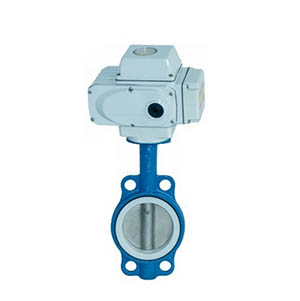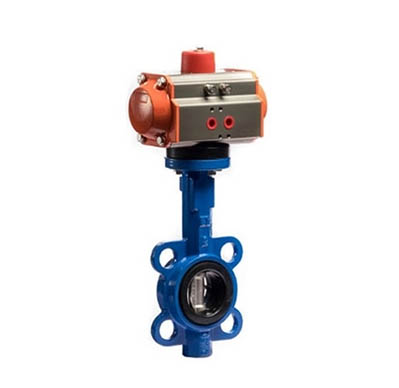Pneumatic and Electric Butterfly Valve: What are their differences?
There is no difference between the butterfly valves themselves, the difference lies in their respective actuators and the applicable working conditions affected by the actuators. Among them, butterfly valves can be divided into pneumatic butterfly valves and electric butterfly valves, both of which are widely used in the market.
These two butterfly valves are easily confused because of the difference in driving energy. This kind of valve with structural similarity is more likely to be confused in procurement and use, so buyers need to fully grasp the principles and advantages of the two. Here is a detailed introduction to the difference between them. Let's take a look.
Basics
Electric butterfly valve
The electric butterfly valve is a butterfly valve that drives the valve switch with an electric valve actuator, which is powered by electricity. The electric  butterfly valve belongs to a variety of electric valves and electric regulating valves. The electric butterfly valve controls the switch of the butterfly valve through the power signal, and uses a single-phase or three-phase motor to drive a gear or a worm gear to output linear or rotary motion. Electric butterfly valves can be divided into flanged butterfly valves and wafer butterfly valves.
butterfly valve belongs to a variety of electric valves and electric regulating valves. The electric butterfly valve controls the switch of the butterfly valve through the power signal, and uses a single-phase or three-phase motor to drive a gear or a worm gear to output linear or rotary motion. Electric butterfly valves can be divided into flanged butterfly valves and wafer butterfly valves.
The product can be used as shut-off valve, control valve and check valve in piping system. With a manual control device, once a power failure occurs, it can be temporarily operated manually without affecting the use. The electric actuator can output a relatively constant driving force with strong anti-deviation ability and higher control precision than the pneumatic actuator can automatically maintain the position without resorting to other auxiliary systems.
Pneumatic butterfly valve
The pneumatic butterfly valve is composed of a pneumatic valve actuator and a butterfly valve, and is a butterfly valve that drives the valve switch with a pneumatic valve actuator. Powered by compressed air, it has the characteristics of simple structure and convenient maintenance, but it is bulky and requires air source and air purification device. The actuator and adjustment mechanism of the pneumatic actuator are a unified whole, and its actuators include film type, piston type, fork type and rack and pinion type.
The pneumatic butterfly valve is a pneumatic valve that uses a circular butterfly valve plate that rotates with the valve stem to open and close to achieve the activation action. It is mainly used as a shut-off valve, and it can also be designed to have a regulating function. It is used more and more in low-pressure large and medium-diameter pipelines. Pneumatic butterfly valve classification: stainless steel pneumatic butterfly valve, hard seal pneumatic butterfly valve, soft seal pneumatic butterfly valve, carbon steel pneumatic butterfly valve. It can be installed in the high-altitude underground passage, and it is easy to operate through the control of the two-position five-way solenoid valve, and the flow medium can also be adjusted.
Working principle
Electric butterfly valve
The working power of the electric butterfly valve actuator usually includes: AC 220V, AC 380V, etc. And the input signal: 4~20mA, 0~10 V and other weak current signals. After the adjustable electric actuator and the valve stem are installed and debugged, the butterfly valve plate is driven by electric energy as the driving force, and the butterfly valve plate is partially reversed and rotated at 0~90°.
Receive the 4~20mA signal from the industrial automation control system to precisely control the opening and closing of the valve, so as to achieve the adjustment and control of different demand parameters such as flow, temperature, and pressure.
Pneumatic butterfly valve
The pneumatic butterfly valve enters the pneumatic actuator through the compressed air to drive the actuator to move the circular butterfly valve plate to make a 90° rotational movement, which is used as a pipeline switch and flow adjustment. The pneumatic butterfly valve works on the opening and closing of 0-90 degrees.
to make a 90° rotational movement, which is used as a pipeline switch and flow adjustment. The pneumatic butterfly valve works on the opening and closing of 0-90 degrees.
That is to say, 0 degrees is the fully closed state, and 90 degrees is the fully opened state. Add a positioner to the pneumatic actuator and input the corresponding signal to adjust the butterfly valve plate arbitrarily from 0 to 90 degrees. It can be used as a pneumatic regulating butterfly valve. In addition, filter pressure reducing valves and solenoid valves can be added to better control the use of pneumatic butterfly valves.
The pneumatic butterfly valve uses gas as the power medium, which has the advantages of high safety and low requirements for the use environment. However, due to the compressibility of the gas, the pneumatic valve actuator with relatively low stiffness has slow response, poor resolution, low control accuracy, and weak anti-deviation ability. It is applied in the case of large dynamic force or friction. And its energy-to-weight ratio is poor, the power density is low, and the pneumatic actuator with large driving force is extremely complicated, heavy and expensive.
Performance
The electric valve limit switch is inside the valve, and the pneumatic butterfly valve has limit switch and air source filter. The switching speed of the pneumatic valve is faster. The pneumatic butterfly valve can be switched on and off in one second. The electric butterfly valve is relatively slow in switching, and generally takes 15-30 seconds to switch.
Relatively speaking, the cost of electric butterfly valves is higher than that of pneumatic valves. If there is an air source on site, it is recommended to use pneumatic valves (generally, the pressure of the air source is 4-6kg), and the applicability of pneumatic valves on the market is higher than that of electric valves.
The service life of the electric butterfly valve is generally less than 10,000 switches, and the service life of the pneumatic butterfly valve can reach millions of switches. But it can only be used for gears with a diameter of 50mm, and gears exceeding 50nm cannot be used.
Relatively speaking, gears below 50nm can only be equipped with DN32 caliber ball valves, and butterfly valves can be equipped with DN100 calibers or less.
The water resistance of the electric butterfly valve is not as good as that of the pneumatic butterfly valve. The water resistance of the electric valve itself is not bad, but some customers do not connect the wiring properly, it will cause water leakage. There are also many electric butterfly valves that are used outdoors.
During the rainy season, if the temperature difference is too large, condensation will occur. Excessive condensed water will cause internal mildew and short circuit, and the circuit boards inside will be easily damaged by condensed water. Therefore, we recommend that customers who purchase electric butterfly valves turn on electricity 2-3 times a month when they are not in use. And the cylinder does not matter, the water resistance of the pneumatic valve will be better.
In terms of power, the pneumatic valve is driven by the air source (the air source comes from the air compressor). After the air source enters, the valve closes, and when the air is discharged, the valve stem is turned to open. The electric valve relies on electric power to drive the butterfly valve plate to roll 90° to achieve the purpose of opening and closing the valve.

